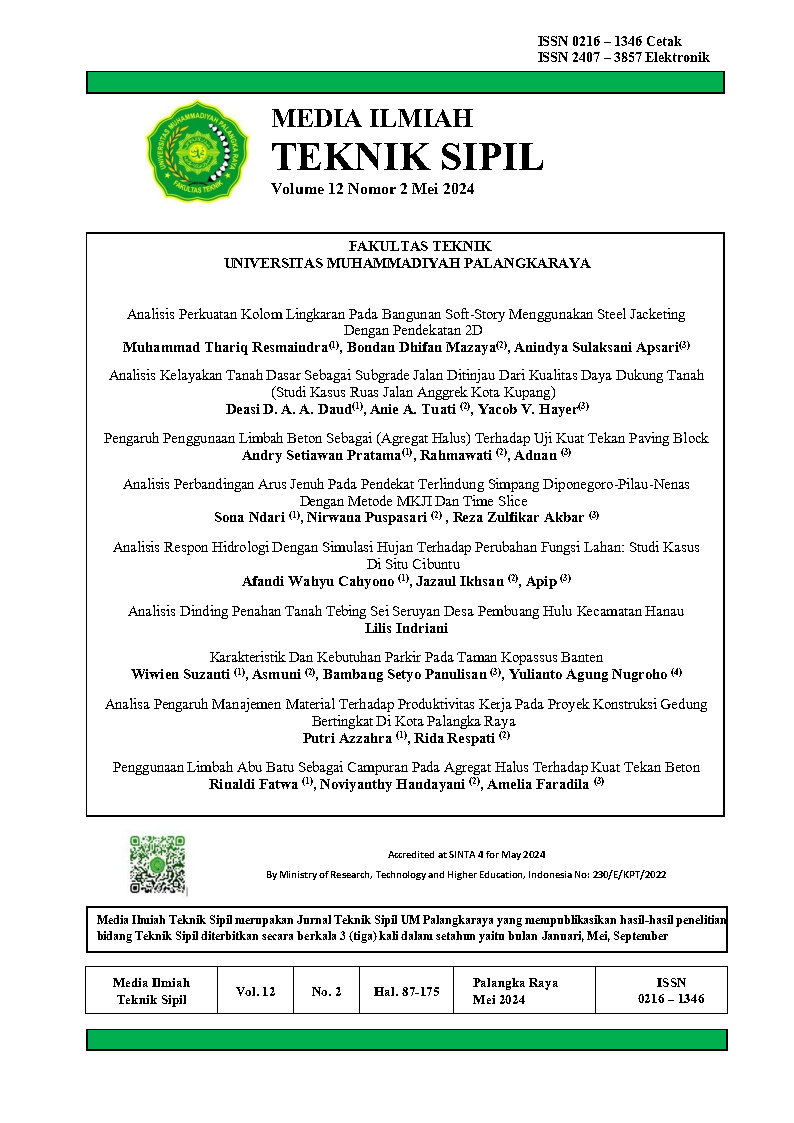Penggunaan Limbah Abu Batu Sebagai Campuran Pada Agregat Halus Terhadap Kuat Tekan Beton Use Of Stone Ash Waste As A Mixture In Fine Aggregate On Compressive Strength Of Concrete
Main Article Content
Abstract
Stone ash is a fine aggregate that passes through sieve no. 4 (diameter 4.75mm) but is retained on sieve no. 200 (0.075mm), thus making stone ash a waste that is useful as a mixture of construction building materials because stone ash can function as a fine aggregate as a substitute for sand in concrete mixtures. The purpose of this research is to find out whether stone ash can be a suitable and good material as a substitute for some of the fine aggregate (sand) in a normal concrete mixture or not, to find out the results of the compressive strength test of concrete by stone ash in a normal concrete mixture, and what percentage composition stone ash which produces optimal concrete compressive strength tests or according to plan. The test object used was a 150 × 300mm cylinder with a total of 36 samples. Stone ash waste with composition ratios of 15%, 25% and 35% has a fairly good bond as an added material to normal concrete mixtures as a substitute for fine aggregate and can even increase the compressive strength of concrete significantly. The composition of stone ash used as a mixture for fine aggregate is 15%, 25% and 35% with a planned concrete quality of 20 MPa and a concrete age of 7, 14 and 28 days. The compressive strength produced by normal concrete without a mixture of stone ash aged 7, 14, and 28 days produces concrete compressive strengths of 13.63 MPa, 19.57 MPa, and 20.53 MPa. Next, for concrete with a rock ash composition of 15% of fine aggregate with an age of 7, 14 and 28 days, the concrete compressive strength is 15.75 MPa, 18.02 MPa, 22.03 MPa. Concrete with a stone ash composition of 25% of fine aggregate with an age of 7.14 and 28 days produces a concrete compressive strength of 15.96 MPa, 19.02 MPa, 21.16 MPa. Concrete with a stone ash composition of 35% of fine aggregate with an age of 7, 14 and 28 days produces a concrete compressive strength of 23.49 MPa, 24.31 MPa, 24.95 MPa. From the research conducted, the 35% composition has the highest compressive strength value of concrete among the other compositions
Downloads
Article Details

This work is licensed under a Creative Commons Attribution-ShareAlike 4.0 International License.
All rights reserved. This publication may be reproduced, stored in a retrieval system, or transmitted in any form or by any means, electronic, mechanical, photocopying, recording.
References
Alfiandinata. (2020). Pengaruh Penggunaan Fly Ash Sebagai pengganti sebagian semen terhadap sifat mekanik beton. Universitas Muhammadiyah Mataram. Mataram.
Candra, A. I., et al (2020). Kuat tekan beton fc’21,7MPa menggunakan water reducing and high range admixtures. Jurnal Ciivila, 5.1, 330-339
Handayani N (2018). Ketahanan Beton Normal Terhadap Air Gambut Di Kota Palangkaraya. Media Ilmiah Teknik Sipil. Palangkaraya
Haris A. HA, Ratih Sekartaji Sambodj, Febri Aditya. (2017). Pengaruh Penggunaan abu batu terhadapt kua tekan beton mutu K-350. Institut Teknologi Adhi Tama Surabaya. Surabaya
Kurnyawan D. (2014). Pengaruh Abu Batu Sebagai Pengganti Pasir Untuk Pembuatan Beton. Fakultas Teknik Universitas Jember. Jember
Ningsih ,R. S. A (2018). Penggunaan White Portland Cement Dan Portland Composite Cement Terhadap Kekuatan Tanah Ekspansif Dengan Unconfined Compression Test. Jurnal Mitra Teknik Sipil. Jakarta
Nurul Isnan Akbar. (2021). Studi Pemanfaatan Abu Batu Dan Fly Ash Pada Beton Berdasarkan SNI-7656-2012 Ditinjau Dari Sifat Mekanis Beton. Universitas Lambung Mangkurat. Banjarmasin
PBI 1971 N.I-2. Peraturan Beton Bertulang Indonesia.Bandung
Setiawati Mira. (2018). Fly Ash Sebagai Bahan Pengganti Semen Pada Beton. Fakultas Teknik Universitas Muhammadiyah Jakarta. Jakarta
SNI 03-1968-1990. Metode Pengujian Tentang Analisis Saringan Agregat Halus Dan Kasar. Badan Standarisasi Nasional (BSN). Jakarta
SNI 03-1969-1990. Metode Pengujian Berat Jenis Dan Penyerapan Air Agregat Kasar. Badan Standarisasi Nasional (BSN). Jakarta
SNI 03-1970-1990. Metode Pengujian Berat Jenis Dan Penyerapan Air Agregat Halus. Badan Standarisasi Nasional (BSN). Jakarta
SNI 03-1971-1990. Metode Pengujian Kadar Air Agregat. Badan Standarisasi Nasional (BSN). Jakarta
SNI 03-1972-1990. Metode Pengujian Slump Beton. Badan Standarisasi Nasional (BSN). Jakarta
SNI 03-1974-1990. Metode Pengujian Kuat Tekan Beton. Badan Standarisasi Nasional (BSN). Jakarta
SNI 03-2471-1991. Metode Pengujian Keausan Agregat Dengan Mesin Abrasi Los Angeles. Badan Standarisasi Nasional (BSN). Jakarta
SNI 03-2493-1991. Metode Pembuatan dan Perawatan Benda Uji Beton Di Laboratorium. Badan Standarisasi Nasional (BSN). Jakarta
SNI 15-2049-2004. Semen Portland. Badan Standarisasi Nasional (BSN). Jakarta
SNI 2847:2013. Persyaratan Beton Struktural Untuk Bangunan Gedung. Badan Standarisasi Nasional (BSN). Jakarta
Sutoyo. Mix Design Beton Normal Berdasarkan SNI T-15-1990-03. DPU Bina Marga. Jawa Timur
Usman U., et al (2018). Studi Kuat Tekan Dan Kuat Tarik Belah Beton Dengan Menggunakan Potongan Limbah Spanduk Sebagai Bahan Tambah. In Fropil (Forum profesional teknik sipil). Bangka Belitung.
Yuono S. S. (2017). Pengaruh Abu Batu Sebagai Campuran Beton Ditinjau Dari Segi Ekonomis Dan Kuat Tekan. Fakultas Teknik Universitas Semarang. Semarang.
